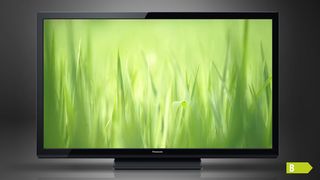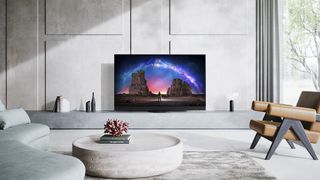Plasma vs OLED: how have televisions improved?
How did OLED improve on the plasma technology that preceded it?

What is a plasma TV? Or rather, what was it? When the flatscreen TV revolution got properly underway towards the end of the last century, it was plasma technology that led the charge into people’s homes, making the flatscreen dream a reality.
As is the case with most emergent consumer electronics technologies, the first domestic plasma TVs were authentically expensive and their performance was compromised in a number of ways. But in all honesty, once customers caught sight of a Fujitsu, Panasonic or Pioneer plasma TV next to their bulky old CRT television, the desire to upgrade was inevitable.
The technology relies on tiny cells filled with ionised gases; when the cell is subject to an electrical charge, the gases become plasma. The process results in a discharge of light (and heat), so three cells containing differently colored phosphors (one red, one green, one blue) can be used to make up one pixel of a display.
Plasma has been a dead technology for a good few years now, with today’s OLED TVs seen as a sort of spiritual successor, even if the underlying technologies are quite different. But how different are they, and why has OLED fared better than its predecessor?
OLED vs plasma: an overview
First, some background. Right now, OLED is the pre-eminent TV technology. It uses Organic Light-Emitting Diodes to create images – and just as with plasma TVs, there are advantages and disadvantages to the technology. However, consumers need only glance at the sleek, slim profiles of OLED TVs to find them deeply desirable. After all, if you want a flatscreen TV, wouldn’t you want the flattest around?
At its most straightforward, an OLED display consists of a layer of organic molecules (which can produce light) sandwiched between layers of voltage conductors. In turn, these are sandwiched between a seal of glass or plastic. Send an electrical charge across the conductors and the organic material will produce light. So, by adding a color filter layer, individual molecules can be designated red, green or blue, operating as the pixels of the display.

Plasma works a little bit differently, but with some of the same perks and advantages over traditional LCD (or CRT) screens. Since plasma powers its pixels individually, it’s possible to turn off a pixel fully – which means plasma screens can display true black in the areas of the screen that need to be so, just as with OLED. Combine that with relative high peak brightness, and plasma screens are able to deliver wide contrasts. In addition, because plasma TVs are capable of high refresh rates, on-screen motion is usually smooth and convincing.
Get daily insight, inspiration and deals in your inbox
Sign up for breaking news, reviews, opinion, top tech deals, and more.
There are downsides, however. Plasma technology is, relatively speaking, inefficient. This hurts it on two counts. First, just like an old-school light bulb, there’s plenty of heat produced at the same time as light; plasma TVs would become noticeably hot when they’d been running for a while, which isn’t overly reassuring customers. And because of this inefficiency, they’re quite power-hungry. While there isn’t a night-and-day difference between the power consumption of a plasma TV and an OLED equivalent, there’s no two ways about it: plasma requires more power than other TV technologies, and is consequently more expensive to run.
The demands of plasma technology mean screens are heavy, too. They require a metal rear and glass at the front, so you can pretty much kiss goodbye to hanging a big plasma screen on a partition wall. Plus, that glass screen means plasma TVs can be terribly reflective; they’re not brilliant for viewing in bright conditions.
OLED vs plasma: what does organic LED do better?

One of the strongest pulls of OLED technology is the slimness of the screens. As long as you ignore the part of the television that’s home to all the necessary electronic hardware, OLED TVs are almost supernaturally slim – and in the showroom, that counts for an awful lot.
Like plasma, OLED controls its image on a pixel-by-pixel basis. So when a pixel isn’t being powered, it’s off – and black as a result. So OLED offers deep black tones and high contrast, thanks to its reasonably high peak brightness levels. Unlike plasma TVs, however, it doesn’t consume a lot of energy to light its pixels, and nor does it generate any discernible heat while it’s operating.
OLED doesn’t require a glass-fronted screen, either. This means it’s lighter than plasma, less reflective, and delivers much wider viewing angles. As such, those folks not fortunate enough to be sitting directly in front of the screen will still get a decent view.
It’s the ‘O’ (organic) part of OLED that creates the perceived difficulties for this technology. Since it uses organic materials, the performance of OLED screens is liable to degrade over time; the most pessimistic estimates reckon an OLED TV is good for ‘only’ around 35,000 hours. Mind you, that’s still 10 years or so, if you watch it for 10 hours a day.
Equally, screen-burn – when the TV retains a suggestion of an image on its screen even when it isn’t being displayed – isn’t quite the deal-breaker some people would have you believe. Yes, if you leave an OLED TV switched to a sports channel, the static part of the image (the channel ident, most likely) could eventually ‘burn’ its way onto the screen. But pretty much every OLED TV has software on board to prevent this happening, even if it means just shifting the image a few pixels at a time.
Is OLED better than plasma?

The short answer is ‘yes’. OLED is less power-hungry and produces brighter images with a wider viewing angle. These days, it has even become less expensive than plasma technology at the point it finally bit the dust as a viable option for consumers back in 2014.
However, there’s no doubting plasma technology democratised flatscreen TVs to the point that every home had one – so we extend our gratitude to plasma even in its absence.
Of course, today’s ‘cutting-edge’ is tomorrow’s ‘quaintly old-fashioned’. You should feel free to investigate your OLED options, but don’t forget to check out our guides to Mini LED and Micro LED while you’re at it. Who knows? In a couple of year’s time, we could be discussing all the ways these new technologies overcame OLED as a consumer technology.
- Check out the best OLED TVs, for want of any plasma options
Simon Lucas is a senior editorial professional with deep experience of print/digital publishing and the consumer electronics landscape. Based in Brighton, Simon worked at TechRadar's sister site What HiFi? for a number of years, as both a features editor and a digital editor, before embarking on a career in freelance consultancy, content creation, and journalism for some of the biggest brands and publications in the world.
With enormous expertise in all things home entertainment, Simon reviews everything from turntables to soundbars for TechRadar, and also likes to dip his toes into longform features and buying guides. His bylines include GQ, The Guardian, Hi-Fi+, Metro, The Observer, Pocket Lint, Shortlist, Stuff T3, Tom's Guide, Trusted Reviews, and more.













